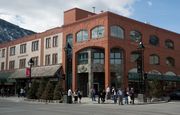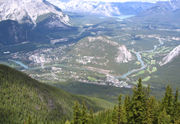Banff, Alberta
| Banff | |||
|---|---|---|---|
| — Town — | |||
| Town of Banff | |||
|
|
|||
|
|||
 Banff
|
|||
| Coordinates: | |||
| Country | |||
| Province | |||
| Region | Alberta's Rockies | ||
| Census division | 15 | ||
| Founded | 1880 | ||
| Government[1] | |||
| - Mayor | John Stutz | ||
| - Governing body | Banff Town Council | ||
| - Manager | Robert Earl | ||
| - MP | Blake Richards | ||
| - MLA | Janis Tarchuk | ||
| Area | |||
| - Total | 4.85 km2 (1.9 sq mi) | ||
| Elevation | 1,463 m (4,800 ft) | ||
| Population (2006)[2] | |||
| - Total | 6,700 | ||
| - Density | 1,381.7/km2 (3,578.6/sq mi) | ||
| - Demonym | Banffite | ||
| Time zone | MST (UTC-7) | ||
| - Summer (DST) | MDT (UTC-6) | ||
| Postal code span | T1L | ||
| Area code(s) | +1-403 | ||
| Website | www.banff.ca | ||
Banff (pronounced /ˈbæmf/) is the largest town in Banff National Park, in Alberta's Rockies, Canada. It is the first incorporated municipality located within a Canadian national park, and at 1,463 m (4,800 ft), it is the town with the second highest elevation in Canada, the highest being Lake Louise. It is surrounded by mountains, notably Mount Rundle, Sulphur Mountain, Mount Norquay, and Cascade Mountain, and is situated above Bow Falls near the junction of the Bow and Spray Rivers. Banff is located 126 km (78 mi) west of Calgary and 58 km (36 mi) east of Lake Louise, on the Trans-Canada Highway. The town is a member of the Calgary Regional Partnership.
Banff is a resort town and one of Canada's most popular tourist destinations, known for its mountainous surroundings and hot springs. It is a major destination for outdoor sports and features extensive hiking, biking, scrambling and skiing areas within the region. Three ski resorts are located in close proximity: Sunshine Village, Ski Norquay and Lake Louise Mountain Resort.
Contents |
History

Banff was first settled in the 1880s, after the transcontinental railway was built through the Bow Valley. In 1883, three Canadian Pacific Railway workers stumbled upon a series of natural hot springs on the side of Sulphur Mountain. In 1885, Canada established a federal reserve of 26 km² around the Cave and Basin hot springs, and began promoting the area as an international resort and spa as a way to support the new railway.[3] In 1887, the reserve area was increased to 673 km² and named "Rocky Mountain Park." This was the beginning of Canada's National Park system.
The area was named Banff in 1884 by Lord Steven, a former Canadian Pacific Railway director, recalling the name of his birthplace, Banff in Scotland.[4] Canadian Pacific built a series of grand hotels along the rail line and advertised the Banff Springs Hotel as an international tourist resort.
Banff townsite developed near the railway station as a service centre for tourists visiting the park. It was administered by the Government of Canada's national parks system until 1990, when the Town of Banff became the only incorporated municipality within a Canadian national park.
In 1985, the United Nations declared Banff National Park, as one of the Canadian Rocky Mountain Parks, a World Heritage Site. Banff remains one of the most popular tourist destinations in Canada.
One of the most notable figures of Banff was Norman Luxton, who was known as "Mr. Banff". He published the Crag and Canyon newspaper, built the King Edward Hotel and the Lux Theatre, and founded the Sign of the Goat Curio Shop, which led to the development of the Luxton Museum of Plains Indians, now the Buffalo Nations Museum.[5] He and his family helped organize the Banff Indian Days and the Banff Winter Carnival.
In 1976, the International Astronomical Union and Working Group for Planetary System Nomenclature (IAU/WGPSN) officially adopted the name Banff for a crater on Mars. Banff Crater, which is attributed to the town of Banff, Alberta, Canada, is located at 17.7° north latitude and 30.8° west longitude on Mars. The diameter of Banff Crater is 5.0 kilometres.[6]
Demographics

King Edward Hotel

The Banff townsite wraps around Tunnel Mountain.

Northern lights over Banff
|
The population of the Town of Banff according to its 2007 municipal census is 8,721, which includes a permanent population of 7,437 and a shadow (non-permanent) population of 1,284.[7][8] The town's growth in recent years has led to concerns among some environmentalists who fear that it will harm the wilderness of the surrounding national park. The federal government has attempted to address these concerns by restricting development in the town, and mandating that only people who can demonstrate a "need to reside"[9] may take up permanent residence in the community.
According to the Canada 2006 Census:[2]
| * Population: | 6,700 (-6.1% from 2001) |
| * Land area: | 4.85 km2 (1.87 sq mi) |
| * Population density: | 1,381.7 people/km² (3,578.6/sq mi) |
| * National population rank (Out of 5,008): | Ranked 544th |
| * Median age: | 32.1 (males: 32.5, females: 31.6) |
| * Total private dwellings: | 2,844 |
| * Dwellings occupied by permanent residents: | 2,568 |
| * Median household income: | $55,017 |
Notable residents
- Karen Percy, who won 2 bronze medals in skiing at the 1988 Winter Olympics
- Kevin Smyth, former NHL player
- Ryan Smyth, NHL player
Climate
Banff experiences a subarctic climate (Köppen climate classification Dfc) that borders on a humid continental climate (Köppen Dfb). Winter temperatures range from a low of −14.1 °C (6.6 °F) to a high of −4.6 °C (23.7 °F). Summer temperatures in the warmest month are pleasant with an average high of 21.9 °C (71.4 °F) and an average low of 7.4 °C (45.3 °F). Snow has been recorded in all months of the year. The annual snowfall averages 234.1 cm (92.2 in).[10]
| Climate data for Banff | |||||||||||||
|---|---|---|---|---|---|---|---|---|---|---|---|---|---|
| Month | Jan | Feb | Mar | Apr | May | Jun | Jul | Aug | Sep | Oct | Nov | Dec | Year |
| Record high °C (°F) | 12.2 (54) |
14.7 (58.5) |
17.2 (63) |
25.6 (78.1) |
29.4 (84.9) |
33.3 (91.9) |
34.4 (93.9) |
33.9 (93) |
31 (88) |
26.5 (79.7) |
16.5 (61.7) |
12.5 (54.5) |
34.4 (93.9) |
| Average high °C (°F) | -4.6 (23.7) |
-0.4 (31.3) |
4.5 (40.1) |
9.5 (49.1) |
14.5 (58.1) |
19.5 (67.1) |
22.9 (73.2) |
22.3 (72.1) |
16.3 (61.3) |
10.1 (50.2) |
0.2 (32.4) |
-5.1 (22.8) |
8.9 (48) |
| Daily mean °C (°F) | -9.3 (15.3) |
-6 (21) |
-1.4 (29.5) |
3.5 (38.3) |
8.1 (46.6) |
12 (54) |
14.6 (58.3) |
14.1 (57.4) |
9.5 (49.1) |
4.4 (39.9) |
-4.1 (24.6) |
-9.2 (15.4) |
3 (37) |
| Average low °C (°F) | -14.1 (6.6) |
-11.6 (11.1) |
-7.3 (18.9) |
-2.5 (27.5) |
1.7 (35.1) |
5.4 (41.7) |
7.4 (45.3) |
6.9 (44.4) |
2.7 (36.9) |
-1.3 (29.7) |
-8.4 (16.9) |
-13.3 (8.1) |
-2.9 (26.8) |
| Record low °C (°F) | -51.2 (-60.2) |
-45 (-49) |
-40.6 (-41.1) |
-27.2 (-17) |
-17.8 (-0) |
-3.9 (25) |
-1.7 (28.9) |
-4.5 (23.9) |
-16.7 (1.9) |
-27 (-17) |
-40.6 (-41.1) |
-48.3 (-54.9) |
-51.2 (-60.2) |
| Precipitation mm (inches) | 27.5 (1.083) |
21.9 (0.862) |
23.4 (0.921) |
32.4 (1.276) |
59.6 (2.346) |
61.7 (2.429) |
54.2 (2.134) |
60.1 (2.366) |
42.1 (1.657) |
29.4 (1.157) |
26.8 (1.055) |
33.2 (1.307) |
472.3 (18.594) |
| Source: Environment Canada[10] | |||||||||||||
Attractions
There are a number of popular mountains located immediately adjacent to the townsite. They include Mount Rundle (2,949 m/9,675 ft), Cascade Mountain (2,998 m/9,836 ft) and Mount Norquay (2,134 m/7,001 ft), which has a ski slope as well as mountain biking trails on the Stoney Squaw portion. The Banff Gondola is available to ascend Sulphur Mountain (2,281 m/7,484 ft) where a boardwalk (Banff Skywalk) beginning from the upper terminal takes visitors to Sanson Peak. Sulphur Mountain is also the location of one of Banff's most popular attractions, the Banff Upper Hot Springs.
Lake Minnewanka located 6 minutes north of the townsite is a very popular day use area with a variety of activities. Mountain biking, hiking and fishing are all activities allowed in this part of the park. There is a very popular Lake Cruise and motor boat rentals and a small food concession available at the marina.
Tunnel Mountain (formerly known as Sleeping Buffalo Mountain) (1,690 m/5,545 ft) is situated within the townsite and is very popular for quick hikes; one can reach the summit in less than half an hour. It was named Tunnel Mountain because surveyors initially wanted to make a tunnel for the Canadian Pacific Railway right through the mountain, instead of following the Bow River Valley.
Banff is home to the well-known Banff World Television Festival, Banff Mountain Film Festival, Rocky Mountain Music Festival and Bike Fest. Banff is also the starting point of the 4417 kilometre Great Divide Mountain Bike Route, which terminates at Antelope Wells, New Mexico in the United States.
Public transport

Each Roam bus is decorated with different images of the National Park.
|
In June 2008, the Banff council launched a local bus system called Roam, with three routes connecting the town, Tunnel Mountain, the Banff Springs Hotel, and the Banff Gondola.[11] The service is operated using four hybrid Nova buses, each decorated with scenes from the National Park.[12] There are two separate routes, Route 1 which goes to Sulphur Mountain and Route 2 which goes to Tunnel Mountain. Many bus stops along the route have screens which tell you exactly how many minutes before the next two buses arrive.
VIA Rail's long-distance trains no longer serve Banff, but the Banff railway station remains in use by the Rocky Mountaineer and Royal Canadian Pacific tour trains.
Media
See also
- List of communities in Alberta
- List of towns in Alberta
- Banff National Park
- Banff Centre
References
- ↑ Town of Banff. "Town Council". http://www.banff.ca/town-hall/banff-town-council.htm. Retrieved 2007-06-30.
- ↑ 2.0 2.1 Statistics Canada (Census 2006). "Banff - Community Profile". http://www12.statcan.ca/english/census06/data/profiles/community/Details/Page.cfm?Lang=E&Geo1=CSD&Code1=4815035&Geo2=PR&Code2=48&Data=Count&SearchText=Banff&SearchType=Begins&SearchPR=01&B1=All&GeoLevel=&GeoCode=4815035. Retrieved 2007-06-12.
- ↑ History of the Town of Banff
- ↑ Banff Heritage Tourism Corporation
- ↑ "The History of Norman Luxton – Founder of the Buffalo Nations Luxton Museum". Buffalo Nations Luxton Museum. http://www.buffalonationsmuseum.ca/bnmhistoryLuxton.html. Retrieved August 31, 2009.
- ↑ "USGS Astro: Planetary Nomenclature: Feature Data Search Results:". United States Geological Survey. http://planetarynames.wr.usgs.gov/jsp/FeatureNameDetail.jsp?feature=60764. Retrieved 2009-04-12.
- ↑ 2007 Municipal Census
- ↑ Alberta Municipal Affairs. "Alberta 2009 Official Population List". http://www.municipalaffairs.alberta.ca/documents/ms/2009pop.pdf. Retrieved 2009-12-11.
- ↑ Need to Reside Requirement
- ↑ 10.0 10.1 Environment Canada—Canadian Climate Normals 1971–2000, accessed 07 July 2009
- ↑ "Roam". Town of Banff. http://www.banff.ca/locals-residents/public-transit-buses/roam.htm.
- ↑ "When in Banff, Roam". Town of Banff. http://www.banff.ca/locals-residents/public-transit-buses/roam.htm.
External links
 |
Lake Louise | Mount Norquay ski resort Cascade Mountain |
Lake Minnewanka |  |
| Sunshine Village | ||||
| Radium Hot Springs | Sulphur Mountain | Canmore |
|
||||||||||||||||||||
|
||||||||||||||||||||||||||||||||||

